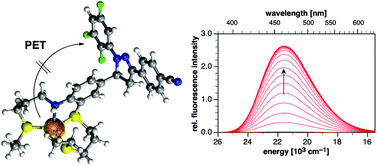High-contrast Cu(i)-selective fluorescent probes based on synergistic electronic and conformational switching†
Abstract
The design of

* Corresponding authors
a
School of Chemistry and Biochemistry and Petit Institute for Bioengineering and Bioscience, Georgia Institute of Technology, 901 Atlantic Drive, Atlanta, GA, USA
E-mail:
fahrni@chemistry.gatech.edu
Fax: +1 404 894-2294
Tel: +1 404 385-1164
b X-ray Crystallography Center, Department of Chemistry, Emory University, 1515 Dickey Drive, Atlanta, GA, USA
The design of

 Please wait while we load your content...
Something went wrong. Try again?
Please wait while we load your content...
Something went wrong. Try again?
A. F. Chaudhry, S. Mandal, K. I. Hardcastle and C. J. Fahrni, Chem. Sci., 2011, 2, 1016 DOI: 10.1039/C1SC00024A
To request permission to reproduce material from this article, please go to the Copyright Clearance Center request page.
If you are an author contributing to an RSC publication, you do not need to request permission provided correct acknowledgement is given.
If you are the author of this article, you do not need to request permission to reproduce figures and diagrams provided correct acknowledgement is given. If you want to reproduce the whole article in a third-party publication (excluding your thesis/dissertation for which permission is not required) please go to the Copyright Clearance Center request page.
Read more about how to correctly acknowledge RSC content.
 Fetching data from CrossRef.
Fetching data from CrossRef.
This may take some time to load.
Loading related content
